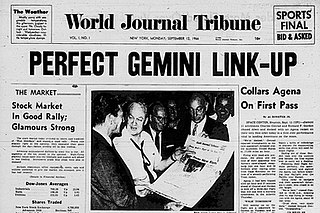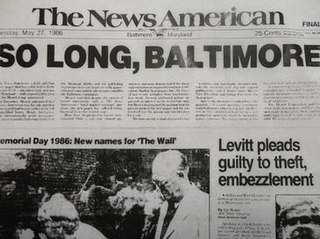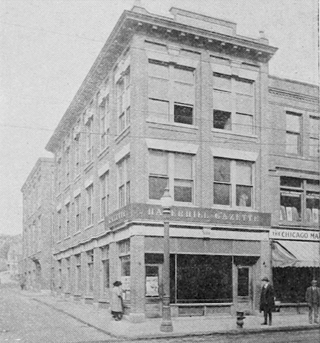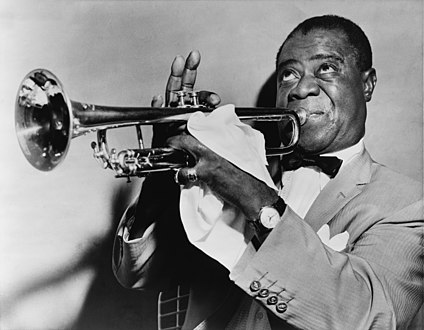Yellow journalism and yellow press are American terms for journalism and associated newspapers that present little or no legitimate, well-researched news while instead using eye-catching headlines for increased sales. Techniques may include exaggerations of news events, scandal-mongering, or sensationalism. By extension, the term yellow journalism is used today as a pejorative to decry any journalism that treats news in an unprofessional or unethical fashion.

The World Almanac and Book of Facts is a US-published reference work, an almanac conveying information about such subjects as world changes, tragedies, and sports feats. It has been published yearly from 1868 to 1875, and again every year since 1886.

The New York Times International Edition is an English-language daily newspaper distributed internationally by the New York Times Company. It has been published in two separate periods, one from 1943 to 1967 and one from 2013 to the present.

The New York Herald was a large-distribution newspaper based in New York City that existed between 1835 and 1924. At that point it was acquired by its smaller rival the New-York Tribune to form the New York Herald Tribune.

The New York Herald Tribune was a newspaper published between 1924 and 1966. It was created in 1924 when Ogden Mills Reid of the New-York Tribune acquired the New York Herald. It was regarded as a "writer's newspaper" and competed with The New York Times in the daily morning market. The paper won twelve Pulitzer Prizes during its lifetime.

The New York World was a newspaper published in New York City from 1860 until 1931. The paper played a major role in the history of American newspapers. It was a leading national voice of the Democratic Party. From 1883 to 1911 under publisher Joseph Pulitzer, it was a pioneer in yellow journalism, capturing readers' attention with sensation, sports, sex and scandal and pushing its daily circulation to the one-million mark. It was sold in 1931 and merged into the New York World-Telegram.

The New York World Journal Tribune was an evening daily newspaper published in New York City from September 1966 until May 1967. The World Journal Tribune represented an attempt to save the heritages of several historic New York City newspapers by merging the city's three mid-market papers together into a consolidated newspaper.
The Syracuse Herald-Journal (1925–2001) was an evening newspaper in Syracuse, New York, United States, with roots going back to 1839 when it was named the Western State Journal. The final issue — volume 124, number 37,500 — was published on September 29, 2001. The newspaper's name came from the merger of the Syracuse Herald and the Syracuse Journal.

The New York Journal-American was a daily newspaper published in New York City from 1937 to 1966. The Journal-American was the product of a merger between two New York newspapers owned by William Randolph Hearst: The New York American, a morning paper, and the New York Evening Journal, an afternoon paper. Both were published by Hearst from 1895 to 1937. The American and Evening Journal merged in 1937.

The Sun was a New York newspaper published from 1833 until 1950. It was considered a serious paper, like the city's two more successful broadsheets, The New York Times and the New York Herald Tribune. The Sun was the first successful penny daily newspaper in the United States, and was for a time, the most successful newspaper in America.

The E. W. Scripps Company is an American broadcasting company founded in 1878 as a chain of daily newspapers by Edward Willis "E. W." Scripps and his sister, Ellen Browning Scripps. It was also formerly a media conglomerate. The company is headquartered at the Scripps Center in Cincinnati, Ohio. Its corporate motto is "Give light and the people will find their own way", which is symbolized by the media empire's longtime lighthouse logo.
The Newspaper Preservation Act of 1970 was an Act of the United States Congress, signed by President Richard Nixon, authorizing the formation of joint operating agreements among competing newspaper operations within the same media market area. It exempted newspapers from certain provisions of antitrust laws. Its drafters argued that this would allow the survival of multiple daily newspapers in a given urban market where circulation was declining. This exemption stemmed from the observation that the alternative is usually for at least one of the newspapers, generally the one published in the evening, to cease operations altogether.

The Baltimore News-American was a broadsheet newspaper published in downtown Baltimore, Maryland until May 27, 1986. It had a continuous lineage of more than 200 years. For much of the mid-20th century, it had the largest circulation in the city.

Frank Andrew Munsey was an American newspaper and magazine publisher and author. He was born in Mercer, Maine, but spent most of his life in New York City. The village of Munsey Park, New York is named for him, along with the Munsey Building in downtown Baltimore, Maryland at the southeast corner of North Calvert Street and East Fayette Street.
The following are the Pulitzer Prizes for 1937.

The Pulitzer Prize for Reporting was awarded from 1917 to 1947.

The New York Evening Telegram was a New York City daily newspaper. It was established in 1867. The newspaper was published by James Gordon Bennett, Jr., and it was said to be considered to be an evening edition of the New York Herald.

The Haverhill Gazette is a weekly newspaper in Haverhill, Massachusetts, owned by Community Newspaper Holdings Inc. of Montgomery, Alabama. For at least part of its history, it was a daily. In 1998 the paper was bought by the Eagle Tribune Company and converted to a weekly. In 2005 it was bought by Community Newspaper Holdings. The publisher is John Celestino, who oversees the Haverhill Gazette and its sister papers in the North of Boston Media Group.

The International Herald Tribune (IHT) was a daily English-language newspaper published in Paris, France for international English-speaking readers. It had the aim of becoming "the world's first global newspaper" and could fairly be said to have met that goal. It published under the name International Herald Tribune starting in 1967, but its origins as an international newspaper trace back to 1887. Sold in over 160 countries, the International Herald Tribune was an innovative newspaper that continued to produce a large amount of unique content until its closure in 2013.
Emily Genauer was an American art critic for the New York World, the New York Herald Tribune, and Newsday. She won the Pulitzer Prize for Criticism in 1974.



















